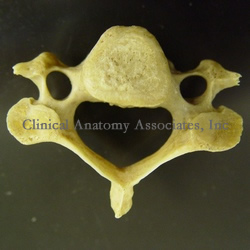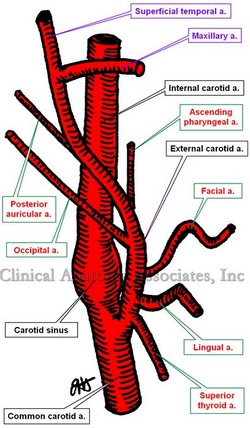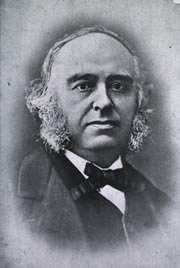
Medical Terminology Daily (MTD) is a blog sponsored by Clinical Anatomy Associates, Inc. as a service to the medical community. We post anatomical, medical or surgical terms, their meaning and usage, as well as biographical notes on anatomists, surgeons, and researchers through the ages. Be warned that some of the images used depict human anatomical specimens.
You are welcome to submit questions and suggestions using our "Contact Us" form. The information on this blog follows the terms on our "Privacy and Security Statement" and cannot be construed as medical guidance or instructions for treatment.
We have 854 guests online

Georg Eduard Von Rindfleisch
(1836 – 1908)
German pathologist and histologist of Bavarian nobility ancestry. Rindfleisch studied medicine in Würzburg, Berlin, and Heidelberg, earning his MD in 1859 with the thesis “De Vasorum Genesi” (on the generation of vessels) under the tutelage of Rudolf Virchow (1821 - 1902). He then continued as a assistant to Virchow in a newly founded institute in Berlin. He then moved to Breslau in 1861 as an assistant to Rudolf Heidenhain (1834–1897), becoming a professor of pathological anatomy. In 1865 he became full professor in Bonn and in 1874 in Würzburg, where a new pathological institute was built according to his design (completed in 1878), where he worked until his retirement in 1906.
He was the first to describe the inflammatory background of multiple sclerosis in 1863, when he noted that demyelinated lesions have in their center small vessels that are surrounded by a leukocyte inflammatory infiltrate.
After extensive investigations, he suspected an infectious origin of tuberculosis - even before Robert Koch's detection of the tuberculosis bacillus in 1892. Rindfleisch 's special achievement is the description of the morphologically conspicuous macrophages in typhoid inflammation. His distinction between myocardial infarction and myocarditis in 1890 is also of lasting importance.
Associated eponyms
"Rindfleisch's folds": Usually a single semilunar fold of the serous surface of the pericardium around the origin of the aorta. Also known as the plica semilunaris aortæ.
"Rindfleisch's cells": Historical (and obsolete) name for eosinophilic leukocytes.
Personal note: G. Rindfleisch’s book “Traité D' Histologie Pathologique” 2nd edition (1873) is now part of my library. This book was translated from German to French by Dr. Frédéric Gross (1844-1927) , Associate Professor of the Medicine Faculty in Nancy, France. The book is dedicated to Dr. Theodore Billroth (1829-1894), an important surgeon whose pioneering work on subtotal gastrectomies paved the way for today’s robotic bariatric surgery. Dr. Miranda.
Sources:
1. "Stedmans Medical Eponyms" Forbis, P.; Bartolucci, SL; 1998 Williams and Wilkins
2. "Rindfleisch, Georg Eduard von (bayerischer Adel?)" Deutsche Biographie
3. "The pathology of multiple sclerosis and its evolution" Lassmann H. (1999) Philos Trans R Soc Lond B Biol Sci. 354 (1390): 1635–40.
4. “Traité D' Histologie Pathologique” G.E.
Rindfleisch 2nd Ed (1873) Ballieres et Fils. Paris, Translated by F Gross
"Clinical Anatomy Associates, Inc., and the contributors of "Medical Terminology Daily" wish to thank all individuals who donate their bodies and tissues for the advancement of education and research”.
Click here for more information
- Details
The lunate bone is one of the proximal carpal bones that form the wrist. The name arises from the Latin [luna], meaning "moon". The lunate bone has a deep concavity and crescent-like shape, resembling a crescent moon. This bone is also known as the "semilunar bone" or the os lunatum.
The lunate bone has six surfaces (as a die). It articulates with the scaphoid bone by way of a strong ligament, the scapholunate interosseous ligament. This ligament has several components. Besides the scaphoid bone, the lunate bone articulates with the radius, capitate, hamate, and the triquetrum.
The accompanying image shows the anterior (volar) surface of the wrist. Click on the image for a larger picture.
Image modified from the original: "3D Human Anatomy: Regional Edition DVD-ROM." Courtesy of Primal Pictures
- Details
The term [endarterectomy] is composed by the prefix [end-] (sometimes used as [endo]), meaning "inner" or "internal"; the root term [-arter-], meaning "artery", and the suffix [-ectomy] meaning "removal" or "excision".
An endarterectomy is performed to remove atheromatous plaque that is causing arterial stenosis. Although every artery is a candidate for this procedure, carotid endarterectomy is one of the most frequently peripheral vascular procedures performed.
The plaque causing arterial stricture can be the origin of thrombi (in situ blood clots), or emboli (loose blood clots that travel with the flood of blood). These emboli can be the cause of cerebral transient ischemic attacks (TIA's).
In an endarterectomy the objective is to remove the inner layer of the vessel containing the atheroma. This layer is the tunica intima of the vessel. The problem when performing the procedure is to maintain perfusion of the brain which receives much of its blood supply trough the internal carotid artery. The brain also receives blood through the vertebral arteries and the contralateral internal carotid artery. All these vessels are interconnected at the base of the brain by the arterial circle of Willis, named after Thomas Willis (1621 - 1675)
For a YouTube video of the procedure: CLICK HERE (9 minutes)
For an image of the carotid plaque in situ: CLICK HERE
The image shows an anterior view of the right-side carotid system.
Images property of: CAA.Inc. Artist:Dr. E. Miranda
- Details
A [hordeolum] is an inflamed Meibomian gland (also known as a tarsal gland). These glands are found at the edge of the eyelids and their lipid product (meibum) helps seal the eyes and prevent tear evaporation. The vernacular term for an hordeolum is "stye" or "sty".
The term arises from the Latin [hordeum] meaning "barley". It refers to the appearance of the inflamed gland to a barleycorn. The eponymic term "Meibomiam gland" honors Heinrich Meibom (1638-1700), a German anatomist who first described the tarsal glands of the eye.
The removal of a hordeolum is called a "hordeolectomy"
The accompanying image shows a five-day old hordeolum.
Image courtesy of Wikipedia
- Details

Click for a larger image
From the Greek [spondylos] meaning "vertebra", its combining form is [spondylo-]. Use of this term include:
- Spondylitis: Inflammation of a vertebra.
- Spondylosis: The suffix [-osis] means "condition", but with the connotation of "many". The term means "many vertebrae", but it refers to excessive abnormal growth of portions of the vertebral body, usually forming "bone spurs", also referred to as "spondylophytes"
- Spondylolysis: From the Greek [lysis], meaning "loosening", the term is used to mean "destruction" or "breaking of". Spondylolysis refers to the breakage, destruction, or loosening of part of a vertebra.
- Spondylolisthesis: From the Greek term [olisthos] meaning "slippery". A "slippery vertebra", referring to the anterior (or posterior) displacement of a vertebra over another one.
Image property of: CAA.Inc. Photographer: David M. Klein
- Details
This article is part of the series "A Moment in History" where we honor those who have contributed to the growth of medical knowledge in the areas of anatomy, medicine, surgery, and medical research.
Peter Paul Broca (1824- 1880). Surgeon and anthropologist, Peter Paul Broca was born in Sainte-Foy-la-Grande in France. His earlier studies were in mathematics, but graduated in medicine, becoming a professor of clinical surgery. He became interested in anthropology and applied his mathematical expertise to the measurement and interpretation of his findings in comparative anatomy.
Broca was the founder of the first Anthropological Society of Paris, and used this venue to deliver most of his work. A prolific writer, Broca published over 500 scientific papers and several books. At one of the meetings of the society the discussion was directed to brain areas and speech. Broca had a patient with a condition that he referred to as aphemia (later known as aphasia); this patient died a few days later and upon autopsy, Broca was able to see a distinct cavity in the left lateral frontal lobe. Upon finding the same situation in another patient, he was able to describe the area of the brain responsible for speech, known today as "Broca's area" in the third left frontal brain convolution. Broca is responsible for naming many of the craniometric points in the human skull such as bregma, dacryon, inion, lambda, metopion, etc.
Broca was part of the discovery and study of the Neanderthal man. He remained the secretary of the Anthropological Society of Paris until his death in 1880.
Original image in the public domain, courtesy of National Institutes of Health.
- Details
The term [aphasia] has Greek origins and means "without speech". This pathology was first described by Paul Broca who called it "aphemia".
Aphasia is a total and complete loss of speech. Lesser presentations of this condition should be called [dysphasias) from the prefix [dys-] meaning "abnormal", and [phasia], meaning "speech".
Aphasia is the lack of spoken speech due to cerebral cortex damage in the dominant brain hemisphere, usually the left side in right-handed individuals. There are two main areas of the brain involved in speech: Broca's and Wernicke's. Broca's area is responsible for speech expression (the spoken and written word). Damage to this area causes expressive or motor aphasia (or dysphasia).
Wernicke's area is responsible for the comprehension of speech, the understanding of language. Damage to this area causes receptive or sensory aphasia (or dysphasia). Broca's and Wernicke's areas are connected by an intrahemispheric tract known as the arcuate fasciculus (see image).
pathologies are:
- Agraphia / dysgraphia: Incapacity / difficulty in writing
- Anomia / dysnomia: Incapacity / difficulty in naming objects
- Aphrasia / dysphrasia: Incapacity / difficulty forming phrases or sentences. The patient can communicate with single words, but cannot form sentences.
Image under copyleft agreement courtesy of The Brain from Top to Bottom






